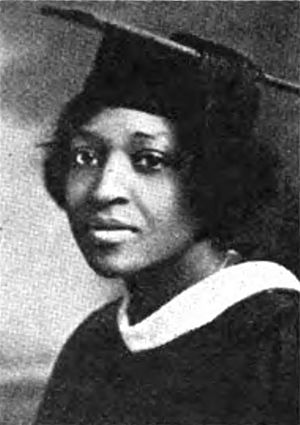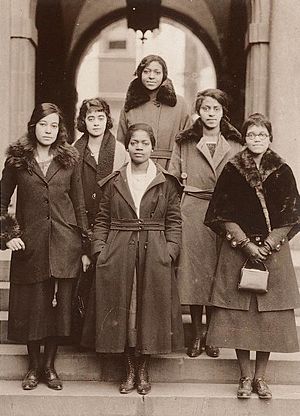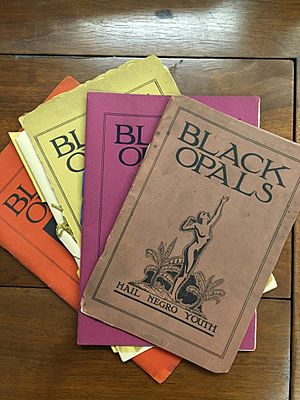Nellie Rathbone Bright facts for kids
Quick facts for kids
Nellie Rathbone Bright
|
|
|---|---|

Nellie Rathbone Bright in 1923
|
|
| Born | March 28, 1898 |
| Died | February 7, 1977 (aged 78) |
| Burial place | |
| Education | University of Pennsylvania (BA 1923) |
| Occupation | Educator, poet, author |
| Years active | 1935 – 1952 |
Nellie Rathbone Bright (born March 28, 1898 – died February 7, 1977) was an American teacher, poet, and writer. She worked in public schools in Philadelphia. She became a school principal in 1935 and retired in 1952. Nellie Bright inspired many African American students during her career.
In the 1920s, she was part of a writing group called the Black Opals. From 1927 to 1928, she helped edit a magazine named Black Opals with Arthur Fauset. This magazine was part of the larger artistic movement known as the Harlem Renaissance.
Nellie Bright was born in Savannah, Georgia. Her parents were both college graduates and professionals. In the early 1910s, her family moved to Philadelphia, Pennsylvania. This move was part of the Great Migration, when many African Americans moved from the South to northern cities. Her father was a priest, and her mother was a teacher. Nellie Bright spent most of her life teaching and leading schools in Philadelphia.
Early Life and Family
Nellie Rathbone Bright was born in Savannah, Georgia, on March 28, 1898. She was the only child of Reverend Richard Bright and Nellie (Jones) Bright. She was named after her mother and grandmother. Her middle name, Rathbone, honored a family friend and social activist.
Nellie's father, Richard Bright, was born in Saint Thomas, U.S. Virgin Islands. He studied at St. Augustine's University in North Carolina. He later earned a degree in religion from the General Theological Seminary in New York in 1891. After this, he became an Episcopal priest. He was the first black Episcopal priest appointed in the Savannah diocese.
Nellie's mother, also named Nellie, was from Louisville, Kentucky. She studied in Europe to avoid the racism common in the American South at that time. When she returned, she became a teacher. In 1892, soon after moving to Savannah, the Brights opened the first private kindergarten and primary school for black children in Georgia.
Around 1910, the Bright family moved to Philadelphia, Pennsylvania. Reverend Bright had accepted a new job there. Philadelphia was a growing city that attracted many black families from the South. They came seeking jobs and better opportunities during the Great Migration. Reverend Bright's church helped these new families settle into city life.
Education and Career
Nellie Bright went to public schools in Philadelphia. She attended Stanton Public School and then William Penn High. She earned a diploma to teach in grade school and also had a special certificate in sewing. In 1919, Bright started studying at the University of Pennsylvania. She earned a bachelor's degree in English in 1923.
While at the University of Pennsylvania, Nellie Bright helped start the Gamma chapter of Delta Sigma Theta. This was the university's first sorority for black women. Other members included Virginia M. Alexander, who became a doctor, and Sadie Tanner Mosell, who was the first woman to get a law degree from the University of Pennsylvania Law School. Bright also helped start another chapter of Delta Sigma Theta, called Xi Sigma.
Bright also studied art at the University of Vermont and the Berkshire School of Art. She traveled a lot as an adult and enjoyed painting landscapes. She also studied at the Sorbonne in France and University of Oxford in England.
After graduating, Bright became a teacher in Philadelphia public schools. In the 1920s, she joined a group of young black writers and thinkers in the city. She and Arthur Fauset started a literary magazine called Black Opals. The magazine's name came from a line in a poem published in its first issue in 1927. The line read "... flame like fire in black opals." Nellie Bright and another poet, Mae V. Cowdery, had poems in that first issue. Their work was praised by Countee Cullen, a famous writer in New York. Their writing group became known as the Black Opals. These groups were common in East Coast cities, inspired by the Harlem Renaissance. Bright and Fauset wanted to publish their magazine four times a year. However, they stopped after only three issues in 1928 because it didn't get enough readers.
In 1935, Bright became the principal of the Joseph E. Hill School in Philadelphia. This school was for black students. One of her former students, Allen Ballard, who later became a writer and history professor, remembered her as a strict principal. He said she taught her students to love and be proud of African American history and culture.
Ballard said that "We were all Nellie Bright's children and she expected great things from us." He added that she made the Hill School "immaculate and vibrantly decorated." She and her staff celebrated the achievements of black people all year. The school walls were covered with posters of heroes like Harriet Tubman, Toussaint L'Ouverture, Frederick Douglass, and Pushkin.
Nellie Bright was a principal at three different schools before she retired in 1952. During her career, she also served on more than fifteen community groups. These groups worked to improve schools and neighborhoods. She cared about her students' lives outside of school. She also worked to improve city health services and encourage cooperation among different groups of people.
Later Years and Legacy
After retiring in 1952, Bright continued to teach. Until 1959, she taught courses to teachers about black history. These classes were held at the Fellowship House in Philadelphia. This organization helps people learn about and understand different cultures.
In 1972, Bright co-wrote a book with Arthur Fauset called America: Red, White, Black, Yellow. This history book was for children and young adults. It focused on the history of minority groups in the United States.
Nellie Bright passed away on February 7, 1977. She is buried in Eden Cemetery in Collingdale, Pennsylvania.
Personal Life
Besides her work in education and writing, Nellie Bright was a talented landscape painter. She painted with oils. She could speak French and Spanish very well.
Bright traveled widely during her life. She visited places in the Caribbean and Europe.
Nellie Bright never married.



